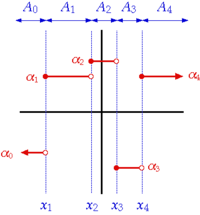Piecewise constant function

Okay, imagine you have a toy train running on a track. Now, let's say there are different sections of the track with different colors. The train moves in a straight line on each section of the track, but it goes at a different speed on each section. This is kind of like how a piecewise function works.
A piecewise constant function is a function that is made up of different pieces or sections, just like the track the train is running on. Each piece of the function is a constant, which means it stays the same value no matter what. So, just like the train going at a certain speed on each section of the track, the function has a certain value for each section.
Let's say we want to plot a piecewise function that looks like this:
f(x) = 2 for x<0
f(x) = 4 for 0<=x<2
f(x) = 6 for x>=2
This means that for any value of x that is less than 0, the function has a value of 2. This is the first piece of the function. Then, for any value of x between 0 and 2, the function has a value of 4. This is the second piece of the function. Finally, for any value of x that is 2 or greater, the function has a value of 6. This is the third and final piece of the function.
So, if we were to plot this function on a graph, it would look like a flat line at 2 until we get to x=0. Then, suddenly, the line would jump up to 4 and stay there until we get to x=2. Finally, the line would jump up again to 6 and stay there for all values of x that are 2 or greater.
In summary, a piecewise constant function is a function made up of different pieces or sections, each of which has a constant value. This is kind of like a train moving at a different speed on each section of a track.
A piecewise constant function is a function that is made up of different pieces or sections, just like the track the train is running on. Each piece of the function is a constant, which means it stays the same value no matter what. So, just like the train going at a certain speed on each section of the track, the function has a certain value for each section.
Let's say we want to plot a piecewise function that looks like this:
f(x) = 2 for x<0
f(x) = 4 for 0<=x<2
f(x) = 6 for x>=2
This means that for any value of x that is less than 0, the function has a value of 2. This is the first piece of the function. Then, for any value of x between 0 and 2, the function has a value of 4. This is the second piece of the function. Finally, for any value of x that is 2 or greater, the function has a value of 6. This is the third and final piece of the function.
So, if we were to plot this function on a graph, it would look like a flat line at 2 until we get to x=0. Then, suddenly, the line would jump up to 4 and stay there until we get to x=2. Finally, the line would jump up again to 6 and stay there for all values of x that are 2 or greater.
In summary, a piecewise constant function is a function made up of different pieces or sections, each of which has a constant value. This is kind of like a train moving at a different speed on each section of a track.
Related topics others have asked about:
